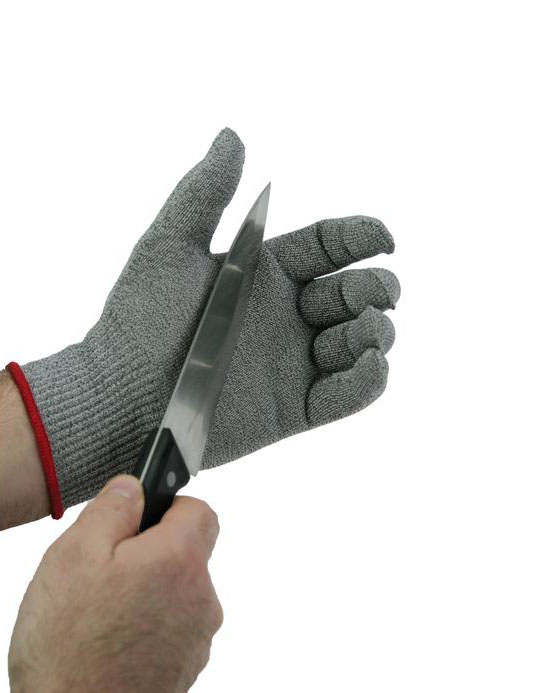How to Select Cut-Resistant Gloves

OSHA and Hand Protection
According to OSHA, 71% of hand and arm injuries could have been prevented with PPE, specifically safety gloves. Yet, 70% of workers don’t wear hand protection. And of those who do, 30% don’t wear the right kind of glove for the task.
 OSHA 1910.138(a) General requirements states that “Employers shall select and require employees to use appropriate hand protection when employees' hands are exposed to hazards such as those from skin absorption of harmful substances; severe cuts or lacerations; severe abrasions; punctures; chemical burns; thermal burns; and harmful temperature extremes.”
OSHA 1910.138(a) General requirements states that “Employers shall select and require employees to use appropriate hand protection when employees' hands are exposed to hazards such as those from skin absorption of harmful substances; severe cuts or lacerations; severe abrasions; punctures; chemical burns; thermal burns; and harmful temperature extremes.”
OSHA 1910.138(b) Selection states that “Employers shall base the selection of the appropriate hand protection on an evaluation of the performance characteristics of the hand protection relative to the task(s) to be performed, conditions present, duration of use, and the hazards and potential hazards identified.”
Rating Gloves for Cut Resistance
ANSI/ISEA-105 is the American National Standard for Hand Protection Classification. This industry-consensus standard addresses the classification and testing of hand protection for specific performance properties related to mechanical protection (cut resistance, puncture resistance and abrasion resistance), chemical protection (permeation resistance, degradation) and other performance characteristics such as ignition resistance and vibration reductions. Gloves are classified to a performance level ranging from 0 to 6 based upon their performance when evaluated against defined industry test methods. Such ratings can assist users to select appropriate hand protection for known specific hazards in the workplace.
The 2016 update to this standard specifically addressed the determination of classification for cut-resistance, including the use of a single test method for testing in an effort to provide consistent meaning of the ratings from the end-user perspective and to model the approach used in similar international standards including European EN388.
Understanding Cut Resistance Classification Levels
When tested in accordance with ASTM F2992-15, the glove’s cut resistance is classified based on the weight needed to cut through the glove material with 20 mm of blade travel.
|
Level |
Weight (grams) needed to cut through glove material with 20 mm of blade travel |
|
A1 |
≥ 200 |
|
A2 |
≥ 500 |
|
A3 |
≥ 1000 |
|
A4 |
≥ 1500 |
|
A5 |
≥ 2200 |
|
A6 |
≥ 3000 |
|
A7 |
≥ 4000 |
|
A8 |
≥ 5000 |
|
A9 |
≥ 6000 |
The glove rating is only a starting point because no laboratory test for cut resistance can completely match actual on-the-job hazards. According to the International Safety Equipment Association:
 Levels A1, A2, A3 protect against scrapes.
Levels A1, A2, A3 protect against scrapes.
Levels A4, A5, A6 protect against cuts for which stitches would be required.
Levels A7, A8 and A9 are meant to offer protection against brutal or extreme injuries.
In addition, other factors such as dexterity, flexibility, abrasion resistance, cost, and other criteria must be considered. Choosing the highest-rated cut-resistant glove is too simplistic.
Cut-Resistant Gloves Higher Than A9
 Metal mesh (or chain-mail) gloves are manufactured from metal wire, usually stainless steel or titanium, for the specific purposes of providing protection from knife cuts in meat, poultry, and seafood processing. Metal mesh gloves are often also used in textile and garment cutting rooms. The performance will be higher than A9 due to the inherent strength of the metal wire. In addition, the testing equipment used for ASTM F2992-15 testing involves electric circuitry which indicates when the blade has cut through the glove material. Obviously a metallic glove material cannot be tested in this manner. The only published standard for metal mesh gloves is European EN 1082-1 “Gloves and arm guards protecting against cuts and stabs by hand knives.”
Metal mesh (or chain-mail) gloves are manufactured from metal wire, usually stainless steel or titanium, for the specific purposes of providing protection from knife cuts in meat, poultry, and seafood processing. Metal mesh gloves are often also used in textile and garment cutting rooms. The performance will be higher than A9 due to the inherent strength of the metal wire. In addition, the testing equipment used for ASTM F2992-15 testing involves electric circuitry which indicates when the blade has cut through the glove material. Obviously a metallic glove material cannot be tested in this manner. The only published standard for metal mesh gloves is European EN 1082-1 “Gloves and arm guards protecting against cuts and stabs by hand knives.”
Recommended Work Practices
As always, personal protective equipment, including hand protection, must be selected considering all of the potential hazards of the job. Laboratory data for cut-resistance as well as resistance to chemicals, abrasion, puncture, extreme temperatures, and other criteria may provide a start to the evaluation process, but human factors for fit, comfort, flexibility, and dexterity must also be considered. This is a continuous process as new materials are developed to enhance cost-effective performance.
Connect with Saf-T-Gard to Learn More
Industrial safety is our legacy going back 9 decades. For an overview of our cut-resistant gloves, please visit Cut-Resistant Gloves.

